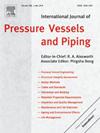Quantitative identification of small defects in pipes using ultrasonic guided waves and synchronized Lorenz equations
IF 3
2区 工程技术
Q2 ENGINEERING, MECHANICAL
International Journal of Pressure Vessels and Piping
Pub Date : 2025-03-15
DOI:10.1016/j.ijpvp.2025.105508
引用次数: 0
Abstract
Defect quantification and signal processing is the important and fundamental problems in ultrasonic guided wave inspection of pipelines. However, the existing methods struggle to accurately identify low SNR guided wave and quantify defects. To overcome this disadvantage, a quantitative detection of small defect in pipeline using synchronized Lorenz equations and guided wave was proposed. Firstly, a method for the quantification and localization of small defects in pipes was developed using the relationship between reflection coefficients, section loss rates and signal amplitudes. Then, two synchronized Lorenz equations were constructed to identify small defects echo. Theoretical derivation and simulation studies showed that the synchronization error can accurately identify the amplitude and peak arrival time of guided waves under strong noise. Finally, experimental research on guided waves inspection of pipeline showed that it could quantitatively identify a pipe small defect with a section loss rate of 2 %. The errors in the defect size and location identification were less than 5 % and 2 %, respectively. Compared to existing study, this study improved the sensitivity of guided waves inspection for the small defect in pipe and its applicability under noise interference.
基于超声导波和同步洛伦兹方程的管道小缺陷定量识别
缺陷的量化和信号处理是管道超声导波检测中的重要和基础问题。然而,现有的方法难以准确识别低信噪比导波和量化缺陷。为了克服这一缺点,提出了一种利用同步洛伦兹方程和导波对管道小缺陷进行定量检测的方法。首先,利用反射系数、截面损失率和信号幅值之间的关系,提出了一种管道小缺陷的量化和定位方法。然后,构造两个同步的Lorenz方程来识别小缺陷回波。理论推导和仿真研究表明,该同步误差能准确识别强噪声条件下导波的振幅和峰值到达时间。最后,对管道导波检测的实验研究表明,导波检测可以定量识别出截面损失率为2%的管道小缺陷。缺陷大小和位置识别的误差分别小于5%和2%。与已有研究相比,本研究提高了导波检测对管道小缺陷的灵敏度和噪声干扰下的适用性。
本文章由计算机程序翻译,如有差异,请以英文原文为准。
求助全文
约1分钟内获得全文
求助全文
来源期刊
CiteScore
5.30
自引率
13.30%
发文量
208
审稿时长
17 months
期刊介绍:
Pressure vessel engineering technology is of importance in many branches of industry. This journal publishes the latest research results and related information on all its associated aspects, with particular emphasis on the structural integrity assessment, maintenance and life extension of pressurised process engineering plants.
The anticipated coverage of the International Journal of Pressure Vessels and Piping ranges from simple mass-produced pressure vessels to large custom-built vessels and tanks. Pressure vessels technology is a developing field, and contributions on the following topics will therefore be welcome:
• Pressure vessel engineering
• Structural integrity assessment
• Design methods
• Codes and standards
• Fabrication and welding
• Materials properties requirements
• Inspection and quality management
• Maintenance and life extension
• Ageing and environmental effects
• Life management
Of particular importance are papers covering aspects of significant practical application which could lead to major improvements in economy, reliability and useful life. While most accepted papers represent the results of original applied research, critical reviews of topical interest by world-leading experts will also appear from time to time.
International Journal of Pressure Vessels and Piping is indispensable reading for engineering professionals involved in the energy, petrochemicals, process plant, transport, aerospace and related industries; for manufacturers of pressure vessels and ancillary equipment; and for academics pursuing research in these areas.

 求助内容:
求助内容: 应助结果提醒方式:
应助结果提醒方式:


